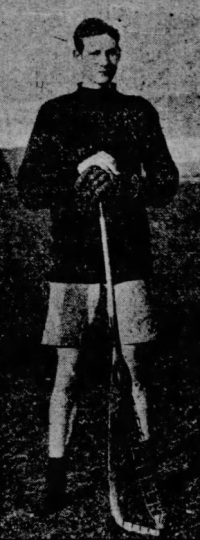
BAYARD (BAY) MARSHALL CARTER
(1895 – October 26, 1974)
Vancouver Athletic Club (1914-1915; 1919)
Vancouver Terminals (1920; 1921-1924)
Vancouver Lacrosse Club (1921)
Bay Carter was part of a core group of local-bred players that included Everett McLaren, Harry ‘Fat’ Painter, and Eustace Gillanders who fortified the Vancouver Terminals defense during their post-war campaigns of the 1920s.
Bayard – known by all as ‘Bay’ – was the son of Emily Lavina Carter (née Barr), who later married Andrew Grieve Waddell, the chief of police of Steveston between 1914 and 1918 and the first chief of police in Richmond. Young Bay would have been around five years-old at the time of his mother’s second marriage on April 19, 1900, which was reported in the press as far away as Owen Sound, Ontario, near where his new step-father originated from. His mother was born in London, England and she was recorded as a 30-year-old widow on their marriage certificate. Waddell’s obituary from 1931 mentions two stepsons, which would have been Bay and his younger brother Stan.
Carter attended the same high school as the Painter brothers with whom he later played alongside on the Vancouver Terminals in the 1920s. Both Bay Carter and ‘Fat’ Painter were also members of the Vancouver Athletic Club senior lacrosse team although they never played in the same season with each other – as ‘Fat’ had moved up to the professional ranks in 1914 when Bay joined the senior amateur team as a much-needed replacement to help fill all the departures of its players to the professional league. Out of around 30 players trying out for the team, Carter was one of those named to the roster on May 13, 1914 and he soon established himself as a crack defender.

When the First World War intervened, Bay Carter served overseas in the military for three to four years – first in the Canadian field artillery with the 46th Battery from Kingston, Ontario and the later as a Royal Air Force pilot. He received his officer’s commission as a lieutenant in 1917. He returned home to Vancouver on July 16, 1919.
He landed work as a mining engineer at Britannia Mines. He then graduated from the University of British Columbia in 1921 with a Bachelor of Science, all the while playing professional lacrosse to pay for his education.
With the Vancouver Terminals, his usual position on the playing field was at first defence and second defence, although when needed he could slot in anywhere from point up through the defensive ranks to centreman. The year after Bay had turned pro and signed with the Terminals, his kid brother Stan Carter also signed with the team and filled the role of substitute.
In one match at Queens Park, on June 24, 1922, Bay had to come to the rescue when his brother was embroiled in a fight with ‘Haddie’ Stoddart of the Salmonbellies, which then quickly exploded into a free-for-all brawl which saw benchwarmers and spectators from the stands spill out on the field to settle old and new scores. It took ten minutes for police and firemen to break up the fight, only for it to erupt again a few seconds later. When the riot finally ended and the dust had settled, and not before old Archie Macnaughton had walloped Pat Feeney in the head with his cane, it was found that most of Vancouver’s equipment – sticks, gloves, and caps – littered about on the ground …had now disappeared! – pilfered by New Westminster youngsters who had run off with anything that had been left laying about during the ensuing chaos.
Once his professional lacrosse days were over, Bay Carter would then find employment embarking on a 36-year career in marketing and advertising. He found this line of work the perfect calling for him, as his imposing six-foot-two frame gave him a deliberate manner of appearance while his mind was full of imagination.
Carter worked for the Vancouver Daily World newspaper for two years, later moving to Farm & Home for eight years. Then the Vancouver Province newspaper became his final employer from January 1931 until his retirement as their advertising director in January 1959. During his years with the Province, he was promoted to assistant advertising manager in 1936, advertising manager in 1941, and director in 1947. When he retired from the newspaper, he was bid adieu with send-off articles printed in both his former employer’s pages as well as those of the crosstown rival Vancouver Sun.
His residence at the time of his retirement was a house located at 6069 Oak Street in Vancouver.
Bayard Carter passed away in 1974. He was survived by his two daughters, Shirley Miller and Nancy Baird, and five grandchildren; his wife Hilda had predeceased him in 1972.
(PHOTO SOURCES: Vancouver Province April 7, 1923; Vancouver Sun September 16, 1914)
